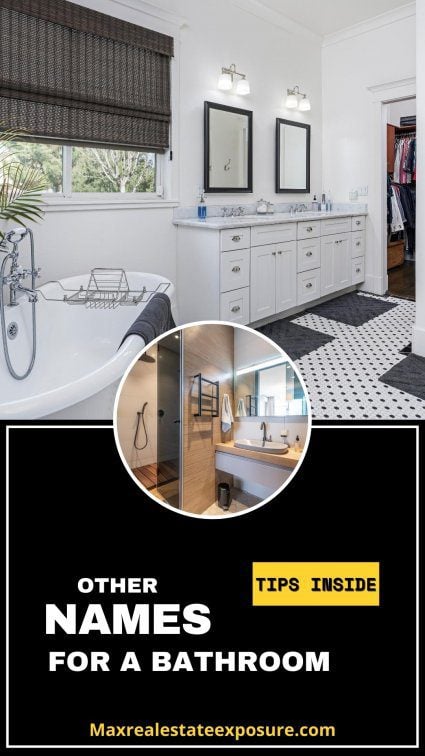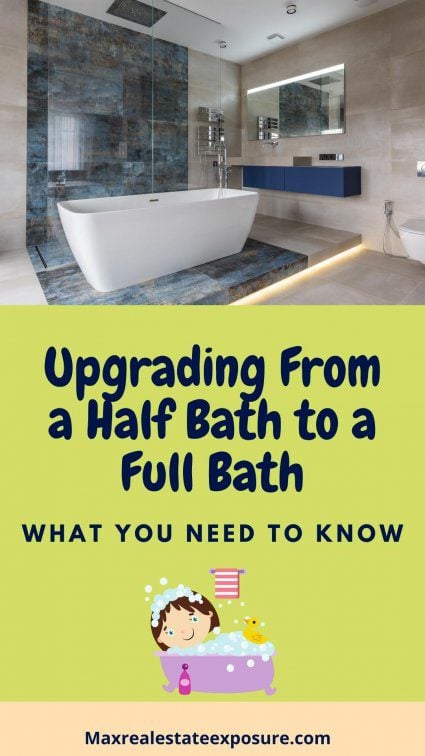The Definition of a Half Bath
 When you are looking to buy a home for the first time, you’re likely to see different and confusing terms. One such term is a 1/2 bath.
When you are looking to buy a home for the first time, you’re likely to see different and confusing terms. One such term is a 1/2 bath.
A half bath is a small room with a toilet and a sink. They do not come with showers or tubs and are usually the smallest rooms in a home.
A half bath has several names, such as a powder room, lavatory, or guest bath.
Most houses have a half bath on the first floor, and those who live in the home and visiting guests use it frequently.
The 1st-floor location is often a standard feature in building homes, making relieving yourself more convenient.
Going up and down stairs whenever you need to go to the bathroom would not make much sense. A half bath is found in many homes off the kitchen or foyer.
The next most common place will be a finished basement. Again, having one in a location where you spend ample time becomes convenient.
Trudging upstairs when you need to go isn’t that pleasant.
How Did Powder Room Become a Synonym For a Half Bath?
Why it is often called a powder room may be a question that crosses your mind.
The term “powder room” originated in the 1920s when people considered it improper for women to use a bathroom to relieve themselves.
Instead, they would use the word powder room to sound more ladylike. A few items often found in a half bathroom include a pedestal sink, hand towels, and towel racks.
A powder room is a small bathroom, even in larger homes.
What is a Full Bath?
A full bath is a room with a sink, toilet, shower, or tub. Sometimes, there will be a tub/shower combination.
A full bathroom is one of a home’s most valuable features, and it is in high demand among today’s home buyers.
Ask any real estate agent doing a competitive market analysis or a real estate appraiser completing an appraisal, and they will tell you it makes a big difference.
Adding a second bathroom will provide the most bang for your buck. A large full bathroom will provide substantial additional property value.
The most significant impact will be an ensuite bath in the primary bedroom. Going from 1.5 to 2.5 baths can make a home significantly more attractive to buyers.
Many buyers specifically look for homes that have a primary bedroom suite.
A Master Bathroom is a High Demand Feature
Some buyers will not even consider purchasing a home without a master suite.
When homes become more significant, and there are more bedrooms, having extra bathrooms also makes a sizable difference in value. Many luxury homes have additional ensuite baths or Jack and Jill bathrooms, where bedrooms share a full bath.
For some buyers, these extra bathrooms can make a difference when buying a particular property. A guest bathroom inside a guest bedroom is a popular selling feature.
Luxury items often fill today’s full baths, including double vanities, granite counters, custom tile showers, and fancy Jacuzzi tubs.
Real Estate listings often emphasize the number of bathrooms and the amenities they include. This bathroom type will increase the value of your home more than any other. People often demand larger bathrooms and frequently see them in a new home.
Other Names For a Bathroom
The following are other names that one could call a bathroom:

- Latrine
- Water closet
- Restroom
- John
- Head
- Outhouse
- Urinal
What is a 3/4 Bath?
Another bathroom type is a three-quarter bath.
The term 3/4 bath is less common. In many areas of the country, the items found in a 3/4 bath will classify it as a full bath. However, some locations call it a three-quarter bathroom if it lacks a tub.
For example, real estate agents list a home in the MLS with a full bathroom, toilet, shower, and sink. A tub is not necessary for it to be considered a full bathroom.
The fix is easy enough in areas not classified as a full bath. For example, some condos and older homes might have a tub, sink, and toilet.
You can easily make it full by adding a shower head over the top of the tub. It is an easy upgrade that can turn a 3/4 bath into a full bath.
What is a 1/4 Bath
Even less common is a 1/4 bathroom. Quarter baths are usually tiny and have only one component. It usually contains just a sink for someone to freshen up or clean their hands.
They can typically be found in basements. If someone has installed a pool but does not have a finished basement, it makes for a convenient place to dry off and change. Keeping water out of the general living area is an excellent option.
Upgrading from a 1/4 bath to a 1/2 bath is usually straightforward if you’ve added rough plumbing. You need to add a toilet; the room would fit the definition.
Be Clear on What is a Half Bath and What Isn’t
In real estate sales, agents often assume that we know more about certain things than the public. Looking at real estate listing in the multiple listing service is second nature.
However, a buyer could look at listings on popular websites for home buyers and be confused. For example, having two half baths does not equal having a full bath.
Real estate descriptions need to be precise so the public is not confused. There is a big difference between these types of baths. The same holds true for sites when finding a rental property.
Should You Upgrade From a Half Bath to a Full Bath?
 If you can upgrade, it will likely be worth it. Unfortunately, because of room size and location, it isn’t always an option for some folks.
If you can upgrade, it will likely be worth it. Unfortunately, because of room size and location, it isn’t always an option for some folks.
Many homes’ bathrooms have limited space, and the plumbing may not allow for extra features or components.
Due to the plumbing, adding a shower and tub to a half bathroom may not be possible. If it is possible, you’ll likely see a good bump in your home value.
As previously mentioned, a bath is one of the most desirable features of a home.
But the bathroom may be fine as-is if it sits on the main level because it can be helpful for guests.
The Value of Adding a Half Bath to Your Home
Adding a half bathroom to your home is not just about convenience. It’s a strategic move that can significantly enhance your property’s value and appeal.
If you are adding an improvement to your home, it’s always nice to know the return on investment (ROI).
According to The National Association of Home Builders, adding a half bath can increase a home’s resale value by approximately 10%, underscoring this modest upgrade’s importance. This increase in value is attributed to the added functionality and appeal to potential buyers, who often seek homes that cater to guests’ needs and provide ample facilities without occupying too much space.
Adding a full bath increases the value by twenty percent. These figures are valid when your bedroom and bathroom count are the same before adding. These percentage increases are about the same in most areas of the US.
The strategic placement of a half bath, especially on the main floor or in areas frequented by guests, can transform the living experience, making it more comfortable and accessible.
Furthermore, the cost of adding a half bath, while not insignificant, is often recouped through the increased value it brings to your home. From my experience as a Realtor, I believe it is a worthwhile investment for homeowners looking to enhance their property’s marketability and functionality.
Understanding the Costs and ROI of Adding a Half Bathroom
Understanding the financial implications is crucial when considering adding a half bath to your home. According to studies done by Home Advisor, on average, homeowners can expect to spend between $5,000 and $15,000 to add a half bath, depending on various factors such as the project’s complexity, materials chosen, and labor costs.
The cost of adding space to your house will average $10,000-$30,000. Making this improvement can undoubtedly increase a home’s value.
Home sellers should consider this when making improvements. An additional bathroom provides plenty of benefits, including better resale value.
This investment is not just about enhancing your home’s functionality. It’s also about the potential return on investment (ROI). Studies have shown that adding a half bath can increase your home’s value by about 55% of the installation cost, making it a financially sound project for many homeowners.
There are some home improvements that don’t add value – this isn’t one of them.
This ROI, coupled with the increased appeal to potential buyers, makes the addition of a half bath a strategic decision that can pay dividends when it comes time to sell your home. To maximize the benefits of this addition, I recommend you work with experienced contractors and consider your home’s layout and design.
Legal Considerations and Permits
Adding a half bath to your home involves more than just design and construction. It also requires understanding the importance of pulling building permits and regulations. Depending on your location, the requirements for permits can vary significantly, impacting both the cost and timeline of your project.
Consulting with the local building department or a professional contractor early in the planning process to understand the specific requirements in your area is essential. This step ensures compliance with building codes and regulations, preventing potential issues or delays.
Additionally, being aware of the legal aspects of home improvement projects can help accurately budget the total costs, including any fees associated with permits and inspections. Taking the time to understand and adhere to these legal requirements is crucial to ensuring that your project proceeds smoothly and adds the intended value to your home.
How Big is a Half Bath?
You’re not alone if you’re wondering how big a half bathroom is. Knowing the average size can be helpful when planning to add one to your house. The average 1/2 bath size is around 16-20 square feet.
There are different bathroom configurations.
The most common dimensions are 6×3, 4×5, or 4×4. The space should be designed to comfortably fit a toilet and vanity.
You should have enough space to add a half bathroom with the above sizes.
Final Thoughts on Bathroom Sizes and Types
Real estate agents often recommend that buyers, sellers, and renovators consider the bathroom size when deciding which option to choose.
The differences between the three bathroom sizes can significantly impact how much space is available in a home or condo and the cost of renovations.
Many different types of bathrooms can be configured differently. Understanding your finances and the reason for adding one can help you decide whether it makes sense to proceed.
Your choices will impact the value and how it is marketed by your real estate agent in the listing. The difference in having 2 1/2 baths vs. 1 1/2 baths could be monumental to some buyers.
About the Author: The above Real Estate information on what a half bath is was provided by Bill Gassett, a Nationally recognized leader in his field. Bill has expertise in mortgages, financing, moving, home improvement, and general real estate.
Learn more about Bill Gassett and the publications in which he has been featured. Bill can be reached via email at billgassett@remaxexec.com or by phone at 508-625-0191. Bill has helped people move in and out of Metrowest towns for the last 38+ years.
Are you thinking of selling your home? I am passionate about real estate and love sharing my marketing expertise!
I service Real Estate Sales in the following Metrowest MA towns: Ashland, Bellingham, Douglas, Framingham, Franklin, Grafton, Holliston, Hopkinton, Hopedale, Medway, Mendon, Milford, Millbury, Millville, Natick, Northborough, Northbridge, Shrewsbury, Southborough, Sutton, Wayland, Westborough, Whitinsville, Worcester, Upton, and Uxbridge Massachusetts.

